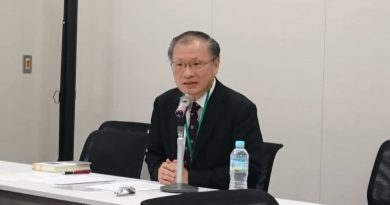The recent human rights situation of Tamil and the militarization of Asia
- Interview with Dr. Jude Lal Fernando
- In a few days, we will commemorate the 12th years of the Tamil massacre in 2009, please tell about the recent human rights situation of Tamil in Sri Lanka.
The civil administration in the Tamil areas is fully controlled by the security forces. Those political and civil leaders who oppose are threatened and arrested. It is totally a military controlled region. In Jaffna district, the soldier/civilian ratio is 1/6. In Mullaiteevu district there are 60,000 solders for 120,000 civilians. This means there is a soldier for every 2 civilians. No public event cannot be organized, even a pre-school children’s event, without the military. You can imagine how repressive the Sri Lankan state is. Whoever openly remembers the massacres of Tamils is harassed and some are arrested under the Prevention of Terrorism Act (PTA). People cannot hold memorial services even for their loved ones who were killed during the war. They are seen as supporters of ‘terrorism’. Sinhala Buddhist monks and settlers are freely allowed to capture land and build Buddhist shrines and villages in the Tamil areas. The security forces and police openly support them. As you know the Muslims have come under heavy attack by the Sri Lankan state. It is a known secret that those suicide attackers on Easter Sunday were very much known to the Sri Lankan security apparatus for years. This group was harassing the Muslims first. On many occasions the Muslim community leaders complained to the state officials against their activities, but they were never arrested. Today the entire Muslim community is being criminalized. The attackers had no deep roots within the Muslim community. Now nearly 1000 Muslims have been arrested under PTA and detained without any charges. This is in addition to thousands of Tamils political prisoners who are being detained after the war. The Muslims are Tamils speaking. On the one hand the attack on the Muslims is another way of repressing the Tamils. On the other hand, the state is making every attempt to divide the Muslims from the rest of the Tamils creating an Islamophobia. But there are Tamil civil society organizations as well as political parties who have formed strong alliances between Christian, Hindu and Muslim communities in resisting these divisions. Recently there was a 700 km march of thousands of Tamils from the East to the North opposing land grab, arrests, detentions and militarization. It was a great moment of solidarity and unity which gives hope. The Sri Lankan state is using the Covid-19 pandemic to stop all protests and further militarize every sphere of the society, not only in the Tamil areas, but also in the Sinhala areas. In fact, 35 major state department and institutions are under the ministry of defense. Over 150 top military officials run them. The President himself is an ex-military officer! Even though the Tamils oppose this, a majority of Sinhalese do not do so because they see security forces as their heroes who won the war against the Tamils.
- At the end of March, Germany finally repatriated about 20 Tamils asylum seekers to Sri Lanka, what does that mean? Is this a signal to a fundamental change in immigration policy in Germany and Europe?
This is a very important question which should be taken seriously. As you know in Europe the far-right forces are gradually gaining power. Even in Germany this is true. They are anti-migrants, anti-refugees, anti-asylum seekers. Angela Merkel’s government welcomed nearly 1 million Syrian refugees, but now her Social Democratic Party (SPD) has entered into a coalition with an anti-refugee political party, the Christian Social Union (CSU) which is in charge of internal affairs. It is the right-wing CSU’s policy which was implemented in deporting the asylum seekers. As you know this is happening not only in Germany and it is not only against Tamils. Angela’s Merkel’s party holds the ministry for foreign affairs which seems to be in conflict with the CSU over this policy. When it comes to the Tamils there is something very special here. The Merkel government fully supported the United Nations Human Rights Resolution on Sri Lanka which will collect information on human rights violations in Sri Lanka. The deportation of Tamils by the internal affairs ministry contradicts the position of the foreign ministry in Germany. In other words, Germany is giving a huge credibility to the far-right government in Sri Lanka by deporting the victims of the Sri Lankan state back to hands of the perpetrators. Eventually this undermines any credibility of the UNHRC processes and legitimizes the Sri Lankan state and its ongoing repression of Tamils. This trend is very dangerous. As you know during the WWII Germany, Japan and Italy made an alliance. It looks like right wing forces in Europe are making alliances with right wing states in Asia, like that of Sri Lanka.
- Could tell us about the Europeans’ point of view on the recent struggle of the people in Myanmar? What kind of concrete solidarity actions are being mobilized there?
There is a growing awareness in European civil society groups regarding mass atrocities committed against the civilians by the military junta. As you know the brutality of the military junta is not new. It has been there for many decades, but this was not taken seriously when Aung San Suu Kyi shared power with the junta. During that time the Rohingya people were targeted. In Europe, activist groups were highly engaged in campaigning for the rights of the Rohingya people. In Europe, Free Burma was the slogan before Aung San Suu Kyi came to power and then Free Rohingya became the slogan after she came to power. Now is the time to combine both slogans; Free Burma, Free Rohyinga. Of course, we should add Free Karens, Kachins, Shan and others. This is like what I said about Sri Lanka where the Tamils and Tamil speaking Muslims should come together. What is most striking in Burma today is the participation of the youth in resistance. The youth in Asia and Europe need to join hands in overcoming racism, military dictatorships and right-wing nationalist politics both in Europe and Asia. We should not forget Dalits in India and Blacks in the USA.
- You recently published a book, “Resistance to Empire and Militarization”, and I want you to talk more about the content of this book and especially about the militarization of Asia. Where can we find hope?
Militarization is the most brutal form of repression of resistance of people. The USA leads the military empire in the world with nearly 800 bases all over the world. A large number of these are in Asia, in particular in East Asia as shown by David Vine’s Book Base Nation. The book I edited contain 21 articles written by activist scholars from highly militarized countries in the world which are led by the USA/UK axis. First of all, the book is a collective effort, not simply my individual attempt. Its aim is not only to show the depth and extent of militarization, but also to highlight multiple modes of resistance arising from people from Okinawa, Tamil Eelam, Kashmir, Palestine Mexico and many other places like South Korea, Turkey, South Africa and so on. In Asia, this militarization has taken a new turn with the USA’s pivot towards Asia as declared by Obama in 2011 at the Australian Parliament. The whole aim is to encircle China. This affects peace in the Korean Peninsula as well as in the Indian subcontinent. Not many know that the massacre of over 100,000 Tamils in 2007 was done as part of preparation for the USA’s pivot towards Asia. In encircling China in the India Ocean by the USA, of course with the support of India, it was necessary to maintain the island of Lanka as a single entity, a unitary state structure. That is why the USA fully backed the Sri Lankan state in completely destroying the Eelam Tamil state in the North and East of the island. The Tamils lead by the Liberation Tigers of Tamils Eelam (LTTE) utilised its military achievements to gain a peaceful political settlement and wanted the Indian Ocean to be declared a peace Zone. In fact, they worked within a peace paradigm which was also backed by liberal EU states. This move was diametrically opposed to the USA’s war paradigm in the Indian Ocean and in encircling China. Today, the USA-India military cooperation has reached unprecedented levels in history. In 2020, three bi-lateral military agreements were signed by the two countries. The USA-led Quadrilateral Security Dialogue (QUAD) which involves Australia, India and Japan is one of the most dangerous moves against peace in the Indo-Pacific region. There are attempts to include South Korea, Taiwan and Vietnam into the alliance. Protecting the Sri Lankan state without any challenge from the Tamils is crucial for this alliance. Strengthening South Korea militarily against North Korea is necessary for this. Where does China stand in this. China is the biggest donor of the Sri Lankan state even though China did not destroy the 2002 peace process between the Sri Lankan state and the LTTE. Today China is entering into same war paradigm of the USA in the Indian Ocean. How? By fully supporting the Sri Lankan state against the Tamils and the Muslims. The book analyses how these geopolitical issues affect the local communities not only in Asia, but also in the Middle East, Africa and Latin America. It wants to show why it is very necessary that the civil society groups should be aware of the ways in which the local reality is connected with the geopolitics. The book aims to building horizontal solidarity. Why do we need it? Not only the Eelam Tamils, but also the collective struggles of all the other oppressed peoples in South Asia as well as in East Asia cannot be taken forward without a demand to declare the Oceans as peace zones. We should demand together that both Indian and Pacific Oceans to be declared as peace zones. The further these Oceans get militarized the more the repression of every progressive movement will continue. As it is important to recognise the sovereignty of North Korea for any peace settlement in East Asia as an equal partner it is necessary to recognise the right to self-determination of Tamils. These demands are within the peace paradigm that oppose the US-led war paradigm. The book also highlights why our understanding human rights has to be broad and deep enough to capture the collective dimension of these struggles. As long as human rights are reduced to individual rights we fall into the military paradigm which is the main perpetrator of all human rights. We should not allow human rights to be used as a tool to further justify militarisation as the USA/UK do. When we recognise the collective rights of the people then we enter into the peace paradigm within which all the rights can be protected.




